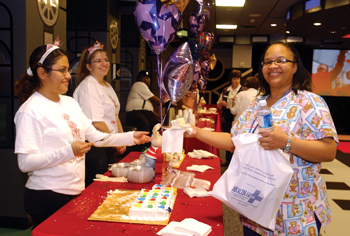
Carol Duran, left, and Ashley Wilson, of Sharon Johnson Catering, and employee Lisa Evans are all smiles during the Monroe Carell Jr. Children's Hospital at Vanderbilt's first birthday party.
photo by Dana Johnson
Birthday bash: Children’s Hospital posts stellar first year

The Monroe Carell Jr. Children's Hospital at Vanderbilt.
photo by Neil Brake

Jay Deshpande, M.D., and Rosie Boyd pose with a Champ cutout during the Monroe Carell Jr. Children's Hospital at Vanderbilt's first birthday party.
photo by Dana Johnson
In the brief span of one year, Vanderbilt Children's Hospital has gotten a new name, a new facility and a visit from the leader of the free world.
The Monroe Carell Jr. Children's Hospital at Vanderbilt also gained national recognition for its design and the service it provides and even helped pass a new lifesaving law, along with other notable achievements.
The newest “baby” of the Vanderbilt family celebrated its first birthday during a party on Tuesday, Feb. 8 at Children's Hospital. Champ, the Children's Hospital's mascot, passed out birthday cake to Medical Center and Children's Hospital faculty and staff.
Champ was also there to unveil a new program, the result of generous donations, which will give each new patient a plush “mini Champ” doll upon being admitted.
“The new Monroe Carell Jr. Children's Hospital at Vanderbilt has become another success story of the Medical Center's growth and expansion,” said Harry R. Jacobson, M.D., vice chancellor for Health Affairs. “It has outperformed all expectations financially, and is operating over budgeted capacity. We are proud of these accomplishments and look forward to the future of the Children's Hospital.”
Added Jim Shmerling, executive director and chief executive officer, “The Medical Center has made a huge investment for the children of our region. Much of our success is due to the countless hours that many faculty and staff throughout the Medical Center spent planning and preparing for this hospital.”
It took five years and $172 million to build the eight-floor, 616,785 square-foot facility that caters to children in the Nashville area and beyond. It took more than a year to plan for the day it officially opened its doors Feb. 8, 2004. That day, all 112 patients were safely moved from their rooms within Vanderbilt University Hospital to the new hospital.
"Our first year in the Monroe Carell Jr. Children's Hospital at Vanderbilt has been extraordinary,” said Arnold Strauss, M.D., Children's Hospital medical director. “This magnificent facility has helped us to attract many new physicians to our pediatric and surgical faculty, has created a family-centered and child-friendly environment for patient care, and generated national visibility as the most incredible children's hospital in the country.”
Since the new hospital opened, services have been expanded to near capacity because of a 30 percent increase in inpatient days and surgical procedures that far exceeded all projections, according to Strauss. With the number of surgeries being performed, the hospital is growing the number of operating rooms from eight upon opening to 12 this spring.
“The growth in operating rooms is evidenced by the fact that we are growing all of our services at a rapid rate, and year-to-date we are up over 16 percent in volume,” said John W. Brock III, M.D., director of the Division of Pediatric Urology and surgeon-in-chief of Children's Hospital.
“We have also seen what an advantage it is to have such outstanding OR facilities as we recruit new faculty for the many different surgical specialties and subspecialties.”
“We are taking care of vastly more critically ill premature infants and children with state-of-the-art equipment and informatics systems,” Strauss added. “It has been a joyful journey toward fulfilling the mission of the best care for children."
After the move last February, the Children's Hospital blossomed beyond all projections. This has continued for the first half of the fiscal year. The original budget for Children's Hospital for the six months that ended Dec. 31, 2004, was to lose $1.4 million, but instead, Children's Hospital made $738,000.
On May 27, just a few months after opening, President George W. Bush visited the Children's Hospital during a trip to Nashville. He was given a demonstration of Vanderbilt's hospital clinical information system by Neal Patel, M.D., an attending physician in the Pediatric Critical Care Unit. Patel also demonstrated StarChart, Vanderbilt's electronic medical record which allows for faster access to patient data such as laboratory values, radiology reports and other information.
State-of-the-art equipment is used throughout the hospital, which can care for 50 more inpatients (not including the 10 beds added in December for the 24 hour observation unit) than the old hospital could accommodate.
This may not seem to be a significant increase until one considers that each child now has his or her own private room filled with family friendly accommodations. Even the Neonatal Intensive Care Unit cares for infants in individual, private rooms, which is greatly different than the old setting of a large room filled with several isolettes.
Surveys completed by approximately 50 parents of infants who were moved from the old NICU in the Medical Center to the new NICU at Children's Hospital found the design of the new NICU aids the hospital's mission of family centered care.
“The survey found the environment in the new NICU was conducive to patient care, family presence, family inclusiveness in rounding and information exchange, while at the same time providing privacy and a developmentally-friendly atmosphere — such as reduced noise, lighting and stimulation for premature babies,” said Brian Carter, M.D., associate professor of Pediatrics, who helped create the survey.
In addition to being aesthetically pleasing for patients, the new hospital has worked to make the experience pleasing to the taste buds of its patients. In October, a new program called Food on Demand gave patients a new child-friendly menu. Within 45 minutes of order, chicken shaped like dinosaurs, colored fish sticks shaped like anchors or star fish and other fun foods can be delivered to rooms.
Much effort has also gone into helping keep children from ever having to enter the Children's Hospital's doors. On July 1, 2004, a new law went into effect to improve the existing law on child restraints in automobiles. The new law now requires that children older than 4 and weighing more than 40 pounds be placed in a booster seat until they are 9 years old and 5 feet tall.
The law was a result of heavy lobbying by Children's Hospital to help keep children safe from injury and by recommendations from other concerned parties. Research conducted at Vanderbilt Children's Hospital showed health care costs for children ages 4 to 7 years old in motor vehicle crashes totaled $2.3 million.
When children sustain life-threatening injuries, minutes can mean the difference between life and death.
In August, a $1.1 million grant from Rutherford County's Christy-Houston Foundation will provide funding to build a much needed lifesaving bridge in the form of a helipad on the roof of the Children's Hospital.
Once opened, children who are transported by helicopter will no longer land atop the Medical Center before receiving treatment at Children's Hospital.
This year has also been a year of growth for the Children's Hospital's physical makeup. In December, three floors of the Doctors' Office Tower (DOT) opened. Floors four, five and six — the first three floors to open — are the new home to many of the pediatric outpatient clinics where about 180,000 children a year are treated. Another clinic, Pediatric Orthopaedics, moved to the fourth floor last week. Other clinics will move to the DOT in the coming months, as construction on floors eight, nine and 11 continues. Floors seven and 10 await funding before construction will begin.
And as part of the move of many clinics to the DOT, space vacated on the sixth floor of the Children's Hospital after the Pediatric Cancer Clinic moved, opened in January. The “C” pod of the sixth floor is now being used to cohort the Cardiothoracic Surgery and Cardiology surgery patients.
Now that the Children's Hospital is in its own freestanding building, it has gained more attention for the service it provides and for its design. In January, Child magazine included Children's Hospital in its list of the Top 10 children's hospitals in the nation. Receiving a ranking of No. 8 overall, cancer services were recognized for its quality of care by receiving a ranking of No. 7 in the country. Architects and designers Earl Swenssen and Associates have received an armload of awards for the hospital's design.
The staff and faculty at Children's Hospital seem to be as energized now as they were on opening day a year ago — taking with them the desire to keep the momentum going into the future.
“I think that this facility was a dream of so many people for so long that one could easily expect there to be some let-down,” Brock said. “After being here for one year, I can tell you that not only is there no let-down but we are continually girded by the growth in services that we provide and the outstanding future that we expect for this children's hospital.”
Added Shmerling, “The heart and soul of the staff has made Children's Hospital the success that it is. Our staff has adjusted very quickly to a new way of working in a new facility, and have joined together to provide an exceptional level of care for children.”













